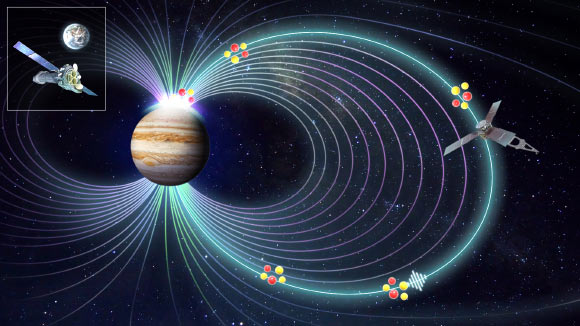The rapidly rotating, strong magnetic field of Jupiter provides a natural lab that is key to understanding the dynamics of high-energy plasmas. Spectacular auroral X-ray flares are diagnostic of the most energetic processes governing magnetospheres but seemingly unique to Jupiter. Since their discovery 40 years ago, the processes that produce these flares have remained unknown until now. In a new study, planetary researchers from the UK, the US, China and Belgium have discovered that the auroral X-ray emissions were triggered by periodic vibrations of Jupiter’s magnetic field lines; these vibrations create waves of plasma that send heavy ion particles ‘surfing’ along magnetic field lines until they smash into the gas giant’s atmosphere, releasing energy in the form of X-rays.
The magnetic field of Jupiter is extremely strong — about 20,000 times as strong as Earth’s — and therefore its magnetosphere, the area controlled by this magnetic field, is extremely large. If it was visible in the night sky, it would cover a region several times the size of our Moon.
On Earth, aurorae are visible only in a belt surrounding the magnetic poles, between 65 and 80 degrees latitude.
Beyond 80 degrees, auroral emission disappears because the magnetic field lines here leave Earth and connect to the magnetic field in the solar wind, which is the constant flux of electrically charged particles ejected by the Sun.
These are called open field lines and in the traditional picture, Jupiter and Saturn’s high-latitude polar regions are not expected to emit substantial aurorae.
However, Jupiter’s X-ray aurorae are inconsistent with this picture. They exist poleward of the main auroral belt, pulsate regularly, and can sometimes be different at the north pole from the south pole.
These are typical features of a ‘closed’ magnetic field, where the magnetic field line exits the planet at one pole and reconnects with the planet at the other.
“We have seen Jupiter producing X-ray aurora for four decades, but we didn’t know how this happened,” said Dr. William Dunn, a researcher in the Mullard Space Science Laboratory and the Centre for Planetary Science at University College London and the Harvard-Smithsonian Center for Astrophysics.
“We only knew they were produced when ions crashed into the planet’s atmosphere.”
Using computer simulations, Dr. Dunn and colleagues previously found that the auroral X-ray flares could be linked to closed magnetic fields that are generated inside Jupiter and then stretch out millions of km into space before turning back.
On July16 and 17, 2017, ESA’s XMM-Newton X-ray observatory observed Jupiter continuously for 26 hours and saw X-ray aurorae pulsating every 27 minutes.
Simultaneously, NASA’s Juno orbiter had been traveling between 62 and 68 Jupiter radii above the planet’s pre-dawn areas. This was exactly the area that the team’s simulations suggested were important for triggering the pulsations.
So, the researchers searched the Juno data for any magnetic processes that were occurring at the same rate.
They found that the pulsating X-ray aurorae are caused by fluctuations of Jupiter’s magnetic field.
As the planet rotates, it drags around its magnetic field. The magnetic field is struck directly by the particles of the solar wind and compressed. These compressions heat particles that are trapped in Jupiter’s magnetic field.
This triggers a phenomenon called electromagnetic ion cyclotron (EMIC) waves, in which the particles are directed along the field lines.
The particles themselves are electrically charged atoms called ions. Guided by the field, the ions ‘surf’ the EMIC wave across millions of km of space, eventually slamming into the planet’s atmosphere and triggering X-ray aurorae.
“Now we know these ions are transported by plasma waves — an explanation that has not been proposed before, even though a similar process produces Earth’s own aurora,” Dr. Dunn said.
“It could, therefore, be a universal phenomenon, present across many different environments in space.”
“Now we have identified this fundamental process, there is a wealth of possibilities for where it could be studied next,” added Dr. Zhonghua Yao, a researcher in the Institute of Geology and Geophysics at the Chinese Academy of Sciences and the College of Earth and Planetary Sciences at the University of Chinese Academy of Sciences.
“Similar processes likely occur around Saturn, Uranus, Neptune and probably exoplanets as well, with different kinds of charged particles ‘surfing’ the waves.”
“X-rays are typically produced by extremely powerful and violent phenomena such as black holes and neutron stars, so it seems strange that mere planets produce them too,” said Professor Graziella Branduardi-Raymont, a researcher in the Mullard Space Science Laboratory at University College London.
“We can never visit black holes, as they are beyond space travel, but Jupiter is on our doorstep.”
“With the arrival of the satellite Juno into Jupiter’s orbit, astronomers now have a fantastic opportunity to study an environment that produces X-rays up close.”
The findings appear in the journal Science Advances.
_____
Zhonghua Yao et al. 2021. Revealing the source of Jupiter’s X-ray auroral flares. Science Advances 7 (28): eabf0851; doi: 10.1126/sciadv.abf0851








